ELID Dressing Behaviors of Non-Abrasive Iron-Based Grinding Wheels
Abstract
:1. Introduction
2. Experimental Setup
3. Results
3.1. Roundness of Grinding Diamond Wheels
3.2. Electrolytic Uniformity
3.3. α-Fe2O3 Particle Content in Oxide Films
3.4. Mechanical Properties of Oxide Layer
3.5. Polishing Experiments of Plate Glass
4. Discussion
4.1. Spark Energy in EDM Dressing
4.2. Effect of Electric Field Uniformity
4.3. Effect of Flow Field Uniformity
4.4. Influence of Oxide Layer Mechanical Properties
4.5. Comparison of Microscopic Morphology in Plate Glass Polishing
5. Conclusions
- (1)
- Both the EDM and ELID electrolytic dressing techniques have demonstrated superior roundness when applied to non-abrasive iron-based grinding diamond wheels, thereby ensuring the feasibility of ELID ultra-precision grinding. The electric field distribution in these non-abrasive iron-based grinding diamond wheels is more evenly dispersed and sensible compared to that in abrasive grinding diamond wheels;
- (2)
- Scanning Electron Microscopy (SEM) results, obtained from four uniformly distributed points around the circumference, confirmed the even distribution of the oxide film on the surface of the non-abrasive iron-based grinding diamond wheels;
- (3)
- Further analysis revealed that the content of α-Fe2O3 particles in the non-abrasive iron-based grinding diamond wheel was 1–2 times that found in the W1.5 iron-based grinding diamond wheel. This increased presence of α-Fe2O3 particles could be a contributing factor to the observed superior performance;
- (4)
- The surface precision achieved when using the non-abrasive iron-based grinding diamond wheel to polish plate glass was significantly enhanced. The surface roughness was measured to be Ra0.5 nm, and no apparent scratches were detected. This reaffirms the potential and effectiveness of non-abrasive iron-based grinding diamond wheels in achieving high-precision results in material processing;
- (5)
- The mechanical properties of the oxide layer on the iron-based grinding diamond wheel without abrasive particles were determined using a nanoindentation instrument, yielding a hardness (H) of 800 MPa, an elastic modulus (E) of 23 GPa, and a stiffness of 0.3 mN/nm;
- (6)
- In subsequent applications, it is possible to adjust the current and voltage during electrolysis to control the thickness of the oxide film formed on the grinding wheel’s surface. Furthermore, by tweaking the wheel formulation and grinding parameters, it is feasible to modify the content of α-Fe2O3 particles within the oxide film. Additionally, adjustments can be made to the mechanical properties of the oxide film on the grinding wheel’s surface. Therefore, the performance of the oxide film is subject to dynamic changes.
Author Contributions
Funding
Institutional Review Board Statement
Informed Consent Statement
Data Availability Statement
Acknowledgments
Conflicts of Interest
References
- Nakagawa, T. Highly efficient and precise grinding using strongly bonded super abrasive wheel. Seisan-Kenkyu J. Inst. Ind. Sci. Univ. Tokyo 1988, 40, 3–8. [Google Scholar]
- Karikomi, K.; Hagiuda, Y.; Nakagawa, T. An improvement of self-dressing ability on the cast iron bonded diamond grinding wheel by mixing grass powder in it. J. Jpn. Soc. Precis. Eng. 1988, 4, 2002–2005. [Google Scholar]
- Karikomi, K.; Nakagawa, T. Creep feed grinding mechanism of fine ceramics by cast iron bonded diamond wheel. J. Jpn. Soc. Precis. Eng. 1988, 54, 2156–2162. [Google Scholar] [CrossRef]
- Yang, M.; Liu, C.; Guo, B.; Liu, K.; Tu, R.; Ohmori, H.; Zhang, S. Understanding of highly-oriented 3C-SiC ductile-brittle transition mechanism in ELID ultra-precision grinding. Mater. Charact. 2023, 203, 113136. [Google Scholar] [CrossRef]
- Ji, B.; Wu, H.; Yang, L.; Liu, C.; Cao, G.; Sun, H. Oxide film thickness and composite mechanical properties of an ultrasonic-assisted ELID cast-iron-bonded grinding wheel. Int. J. Adv. Manuf. Technol. 2023, 127, 3891–3904. [Google Scholar] [CrossRef]
- Zhou, H.; Guo, M.; Wang, X. Ultraprecision grinding of silicon wafers using a newly developed diamond wheel. Mater. Sci. Semicond. Process. 2017, 68, 238–244. [Google Scholar] [CrossRef]
- Wu, Q.; Zheng, W.; Deng, Z.; Zhao, H. Research status and perspectives of ELID grinding oxidation films. China Mech. Eng. 2018, 29, 2023–2030. [Google Scholar]
- Park, K.; Ohmori, H.; Nakagawa, T. Grinding of plastics and carbon fiber reinforced plastics (CFRP) with metal bonded grinding wheel of small diameter. J. Jpn. Soc. Grind. 1995, 39, 33–39. [Google Scholar]
- Ohmori, H. Electrolytic in-process dressing (ELID) grinding technique for ultra precision mirror surface machining. Int. J. Jpn. Soc. Precis. Eng. 1992, 25, 273. [Google Scholar]
- Omori, H.; Takahashi, I.; Nakagawa, T.; Hagiuda, Y.; Karikome, K. Development of ELID mirror surface grinding by cast iron bond grinding wheel. Mon. J. Inst. Ind. Sci. Univ. Tokyo 1997, 49, 339–341. [Google Scholar]
- Guan, J.; Yuan, Z.; Zhang, F.; Luan, D.; Cong, J.; Sun, X. Research on metal cement grinding wheel for ELID mirror grinding. J. Harbin Inst. Technol. 1998, 30, 90–93. [Google Scholar]
- Tian, C.; Wan, Y.; Li, X.; Rong, Y. Study on the additively manufactured porous metal-bonded grinding wheel designed by octahedron lattice structure. Int. J. Adv. Manuf. Technol. 2023, 125, 1743–1756. [Google Scholar] [CrossRef]
- Onishi, H.; Kobayashi, M.; Takata, A.; Ishizaki, K.; Shioura, T.; Kondo, Y.; Tukuda, A. Fabrication of new porous metal-bonded grinding wheel. J. Porous Mater. 1999, 4, 187–198. [Google Scholar] [CrossRef]
- Truong, S.; Isono, Y.; Tanaka, T. A study on the toughening of bond bridge of Ni-Cu-Sn alloy-development of porous metal bonded diamond wheel. J. Jpn. Soc. Precis. Eng. 1998, 64, 923–928. [Google Scholar] [CrossRef]
- Xiong, H.; Liu, M.; Xia, J. Study on grinding performance of porous metal bond diamond wheel manufactured with hollow sphere pore-forming agent. Diam. Abras. Eng. 2011, 31, 44–49. [Google Scholar]
- Itoh, N.; Ohmori, H.; Kasai, T.; Karaki-Doy, T.; Horio, K. Characteristics of ELID surface grinding by fine abrasive metal-resin bonded wheel. Int. J. Jpn. Soc. Precis. Eng. 1998, 32, 273–274. [Google Scholar]
- Maebayashi, N.; Itoh, N.; Ohmori, H.; Katoh, T.; Yamasaki, K.; Ohmiya, K. Development of metal-resin bonded wheel containing electro-conductive rubber balls using green sheets. Proc. JSPE Semest. Meet. 2016, 425–426. [Google Scholar] [CrossRef]
- Itoh, N.; Ohmori, H.; Kasai, T. Development of metal-resin bonded wheel using fine metal powder and its grinding performance. Int. J. Jpn. Soc. Precis. Eng. 1999, 33, 333–334. [Google Scholar]
- Itoh, N.; Ohmori, H.; Moriyasu, S. Finishing characteristics of brittle materials by ELID-lap grinding using metal-resin bonded wheels. Int. J. Mach. Tools Manuf. Des. Res. Appl. 1998, 38, 747–762. [Google Scholar] [CrossRef]
- Hasegawa, Y.; Horibe, T.; Itoh, N.; Ideue, T.; Takahashi, M.; Ohmori, H.; Katoh, T. Development of ELID grinding system for electro-conductive rubber bonded wheel using electrolyzed water: 2nd Grinding characteristics using coolant nozzle with electrolyzed water generator. Proc. JSPE Semest. Meet. 2013, 801–802. [Google Scholar] [CrossRef]
- Sakata, N.; Yamamoto, H.; Ohmori, H.; Itoh, N.; Inazawa, K. Effects of micro-bubble on ELID grinding performance using electro-conductive rubber bonded wheel. Proc. JSPE Semest. Meet. 2018, 13, 765–766. [Google Scholar] [CrossRef]
- Ezura, A.; Inazawa, K.; Omori, K.; Uehara, Y.; Itoh, N.; Ohmori, H. ELID mirror surface grinding for concave molds by conductive elastic wheel containing carbon black. Int. J. Autom. Technol. 2022, 16, 21–31. [Google Scholar] [CrossRef]
- Omiya, K.; Itoh, N.; Kasuga, H.; Ohmori, H.; Kato, T.; Maebayashi, N. ELID grinding performance using metal-resin bonded wheel conducting electro-conductive-rubber ball. Jpn. Soc. Mech. Eng. 2015, 23, 93–94. [Google Scholar]
- Hasegawa, Y. Development of eco-friendly ELID grinding wheel using plant carbon. J. Jpn. Soc. Abras. Technol. 2009, 53, 735. [Google Scholar]
- Huang, J.; Li, W. Study of electrolysis property of bamboo charcoal bonded grinding wheel. New Technol. New Process. 2011, 2, 57–59. [Google Scholar]
- Itoh, N.; Ohmori, H. Development of metal free conductive bonded diamond wheel for environmentally friendly electrolytic In-process Dressing (ELID) grinding. New Diam. Front. Carbon Technol. 2004, 14, 224–238. [Google Scholar]
- Nemoto, A. Development of R.B. ceramics bonded diamond wheel for eco-friendly ELID grinding. J. Jpn. Soc. Abras. Technol. 2004, 48, 578–579. [Google Scholar]
- Wu, Q.; Ouyang, Z.; Yang, H.; Song, K.; Deng, Z. Influence of carbon nanotubes on electrolytic dressing grinding performance of a multi-layer brazed coarse-grained diamond wheel. J. Mech. Eng. 2020, 56, 231–239. [Google Scholar]
- Wu, Q.; Wang, Y.; Zhao, H.; Zheng, W.; Deng, Z. Precision grinding of ultra-fine cemented carbide based on electrolytic in-process dressing of a multi-layer brazed diamond wheel. J. Mech. Eng. 2018, 54, 212–220. [Google Scholar] [CrossRef]
- Chen, J.; Huang, H.; Xu, X. An experimental study on the grinding of Alumina with a monolayer brazed diamond wheel. Int. J. Adv. Manuf. Technol. 2009, 41, 16–23. [Google Scholar] [CrossRef]
- Itoh, N.; Ohmori, H.; Kato, T.; Umezu, S.; Matsuzawa, T. Fabrication of grinding wheel using a combined system of PELID and 3D printer. J. Jpn. Soc. Abras. Technol. 2017, 61, 318–321. [Google Scholar]
- Yamada, N.; Itoh, N.; Mashiko, Y.; Omori, H.; Umezu, S.; Inazawa, K. Attempt of the inner structure grinding wheel by PELID and 3D Printer. Jpn. Soc. Precis. Eng. 2017, 2017, 381–382. [Google Scholar]
- Kashimura, S.; Inazawa, K.; Ohmori, H.; Itoh, N. Development of resin fibrous grinding wheels using twin nozzle PELID and analysis of their grinding performance. Int. J. Autom. Technol. 2021, 15, 49–56. [Google Scholar] [CrossRef]
- Kuai, J.; Zhang, J.; Ardashev, D.V.; Zhang, H. Properties of α-Fe2O3 in oxide film of α-Fe grinding wheel without abrasive particles. Ferroelectrics 2019, 548, 1–7. [Google Scholar] [CrossRef]
- Kuai, J. Grinding point-temperature model of ELID oxide film and its heat transfer and formation mechanism of α-Fe2O3. Nanomater. Energy 2017, 6, 1–6. [Google Scholar] [CrossRef]
- Kuai, J.; Ardashev, D.V.; Zhang, H. Study of α-Fe2O3 formation and its measurement in oxide films of wheel surface during ELID grinding process. Mod. Phys. Lett. B 2017, 31, 1750025. [Google Scholar] [CrossRef]
- Liu, Z.; Ren, C.; Zhao, K.; Chen, G.; He, C. Modeling of oxide-film thickness in electrolytic in-process dressing grinding with workpiece swing. Int. J. Adv. Manuf. Technol. 2022, 122, 1695–1718. [Google Scholar] [CrossRef]
- Lim, H.; Fathima, K.; Kumar, A.; Rahman, M. A fundamental study on the mechanism of electrolytic in-process dressing (ELID) grinding. Int. J. Mach. Tools Manuf. 2002, 42, 935–943. [Google Scholar] [CrossRef]
- Zhang, K.; Ren, C.; Yang, L.; Li, Q.; Jin, X. Precision internal grinding of bearing steel based on the state control of oxide layer with electrolytic in-process dressing. J. Mater. Process. Technol. 2012, 212, 1611–1621. [Google Scholar] [CrossRef]
- Zhang, J.; Yang, Y.; Zhang, X.; Guan, J.; Zheng, L.; Li, G. Experimental study on the characteristic and function of oxide film formed on grinding wheel in ELID precision grinding. Ind. Lubr. Tribol. 2020, 72, 549–555. [Google Scholar] [CrossRef]
- Chen, H.; Li, J. Anodic metal matrix removal rate in electrolytic in-process dressing I: Two-dimensional modeling. J. Appl. Phys. 2000, 87, 3151–3158. [Google Scholar] [CrossRef]
- Alqahtani, B.; Zhang, M.; Marinescu, I.; Bafakeeh, O.; Al Sofyani, S. Microscopic characterization and modeling of oxide layer for electrolytic in-process dressing (ELID) grinding with focus on voltage, electrode-wheel gap, and coolant flow. Int. J. Adv. Manuf. Technol. 2019, 105, 4853–4862. [Google Scholar] [CrossRef]
- Gui, J.; Zhang, F. Study on Calculation Model of Spring Stiffness of Passive Film for ELID Grinding. Tool Eng. 2008, 42, 29–32. [Google Scholar]
- Fathima, K.; Rahman, M.; Senthil Kumar, A.; Lim, H. Modeling of ultra precision ELID grinding. Trans. ASME J. Manu. Sci. Eng. 2007, 129, 296–302. [Google Scholar] [CrossRef]

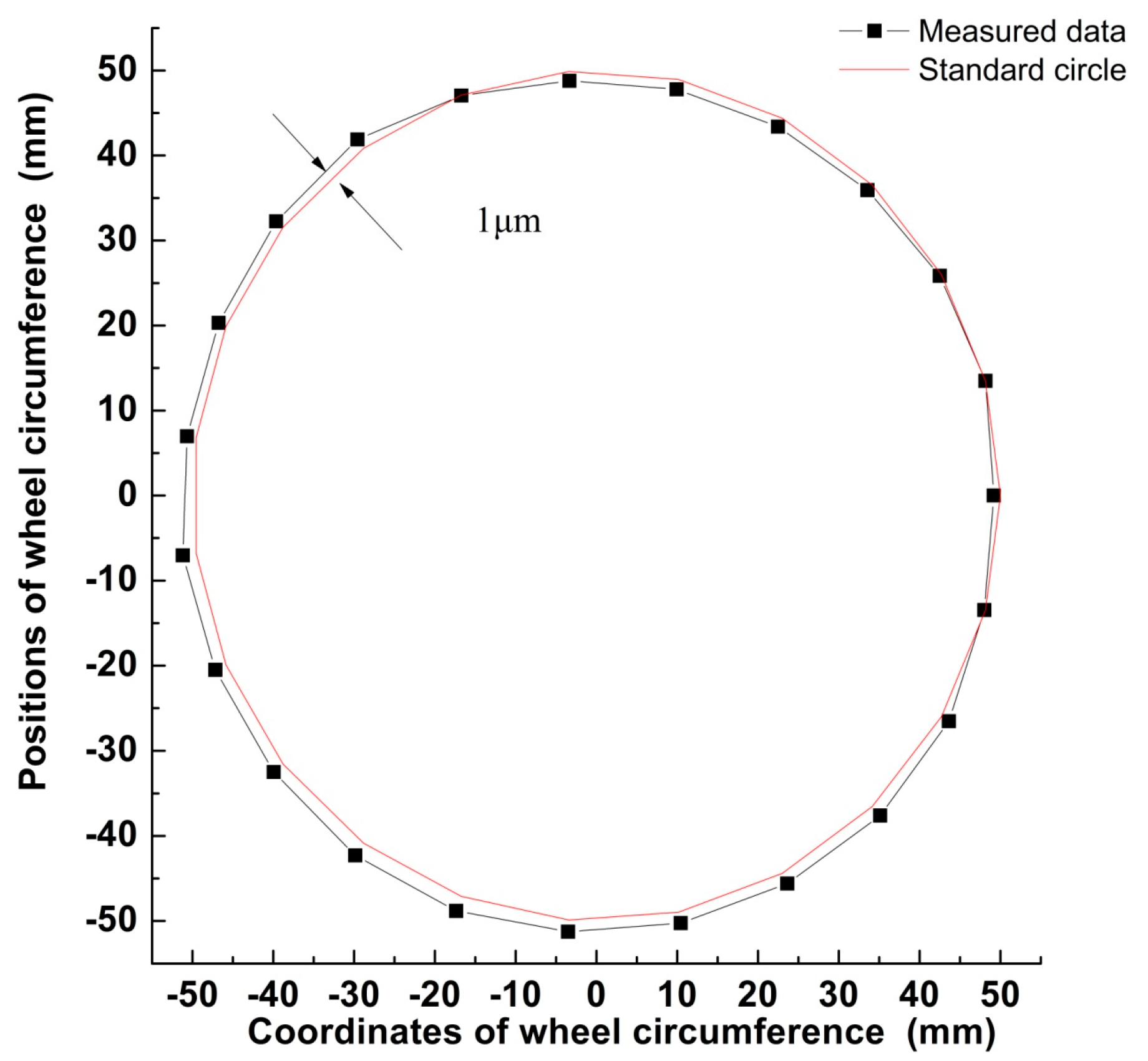

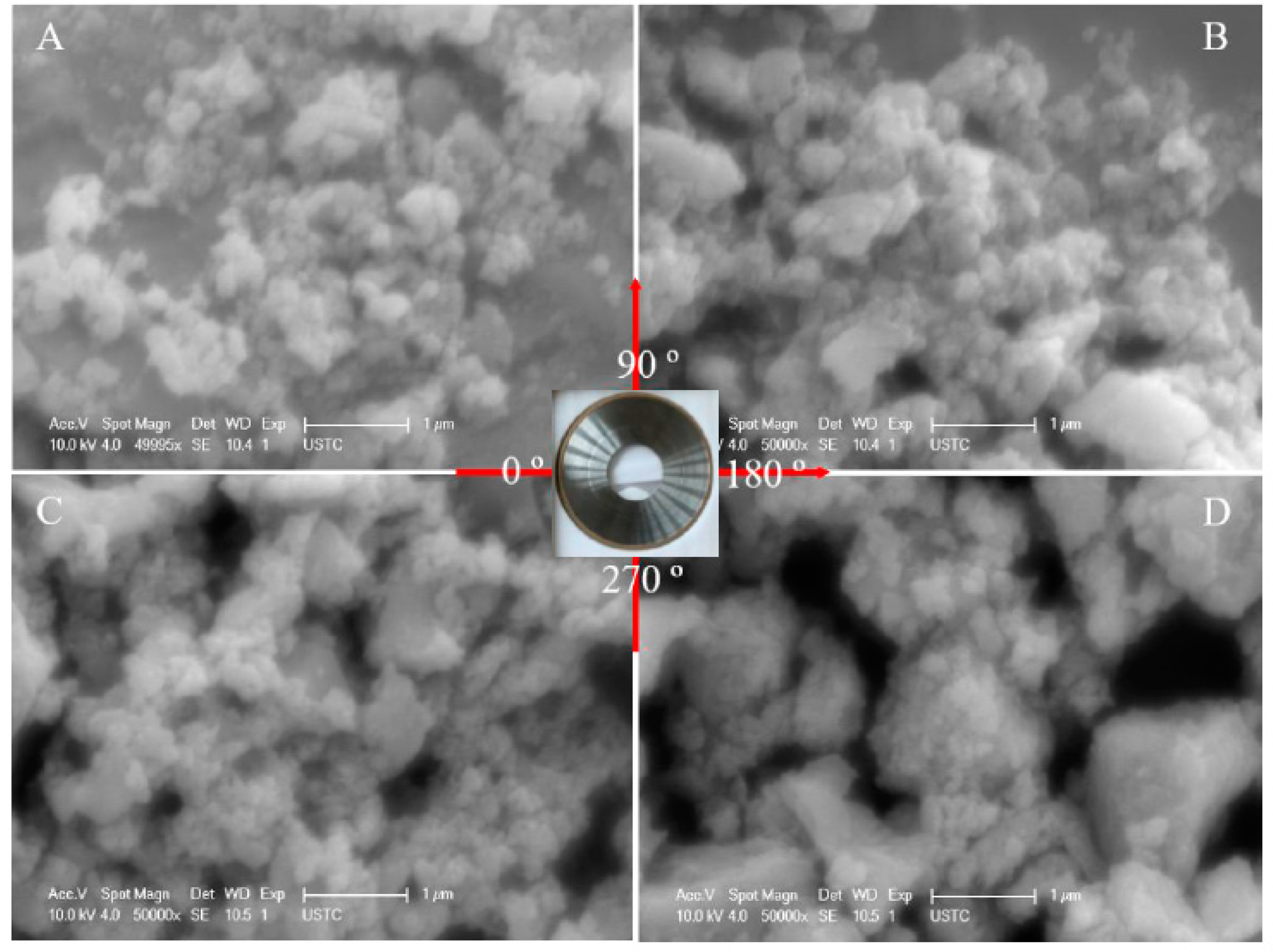
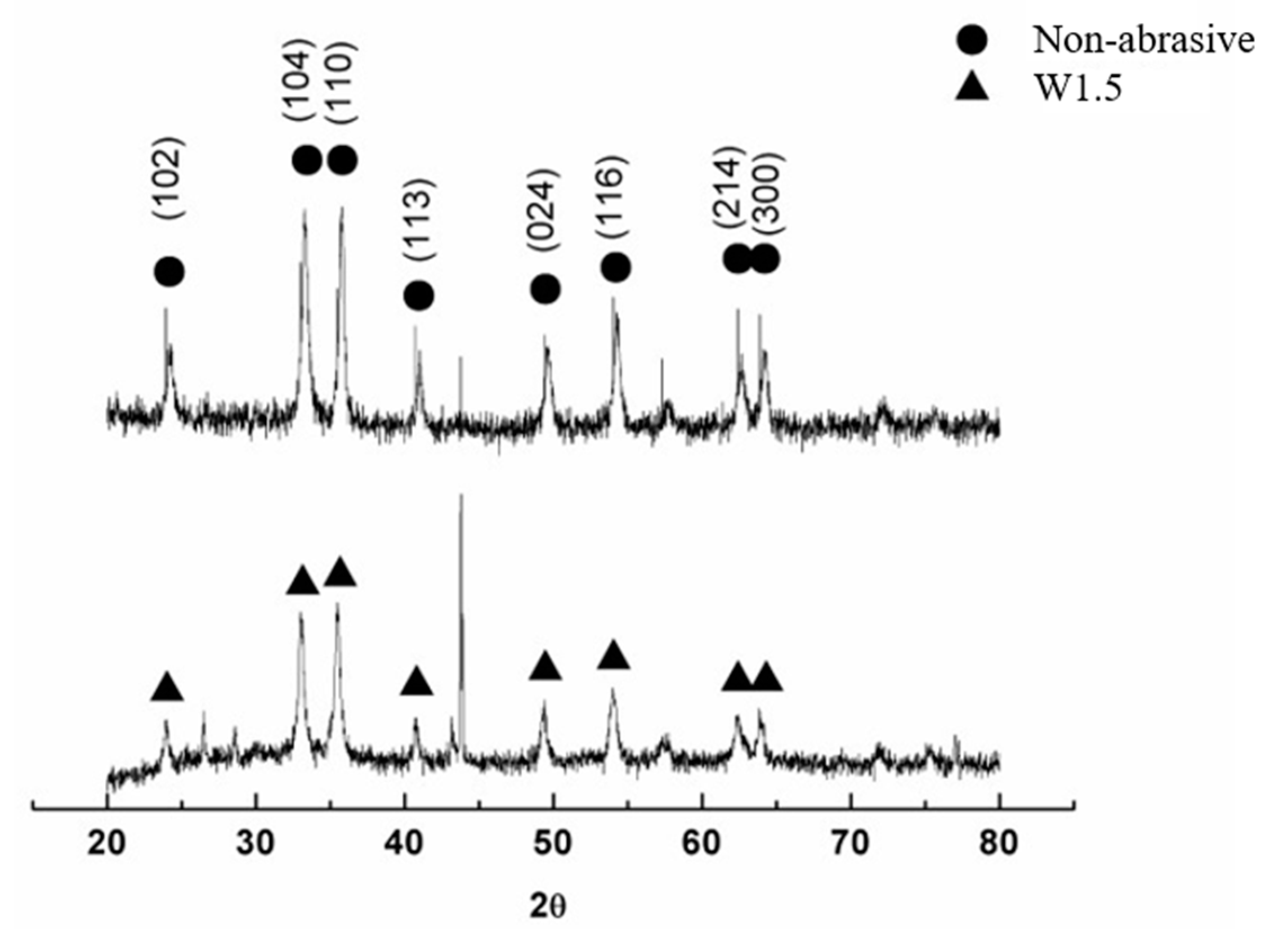
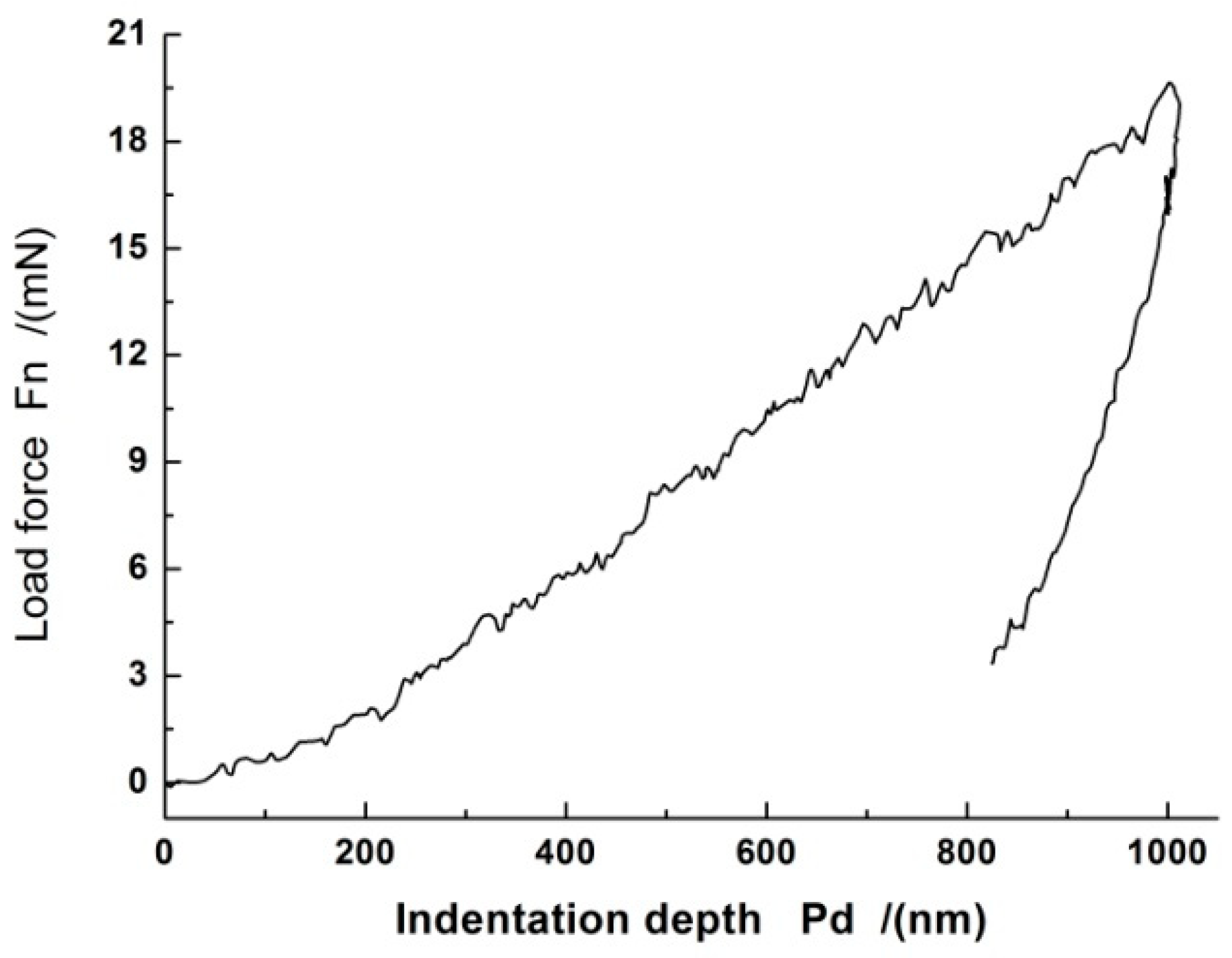
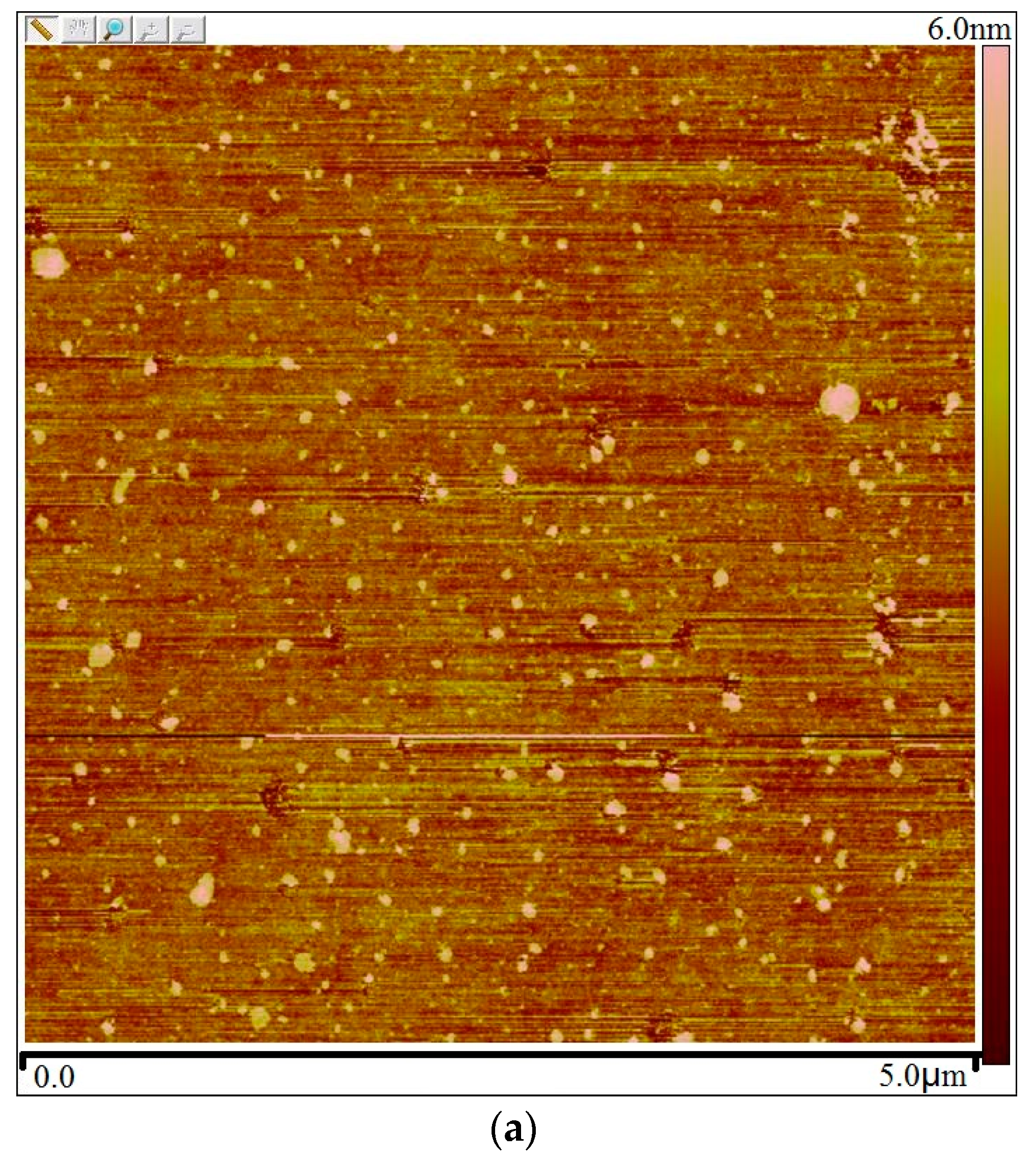
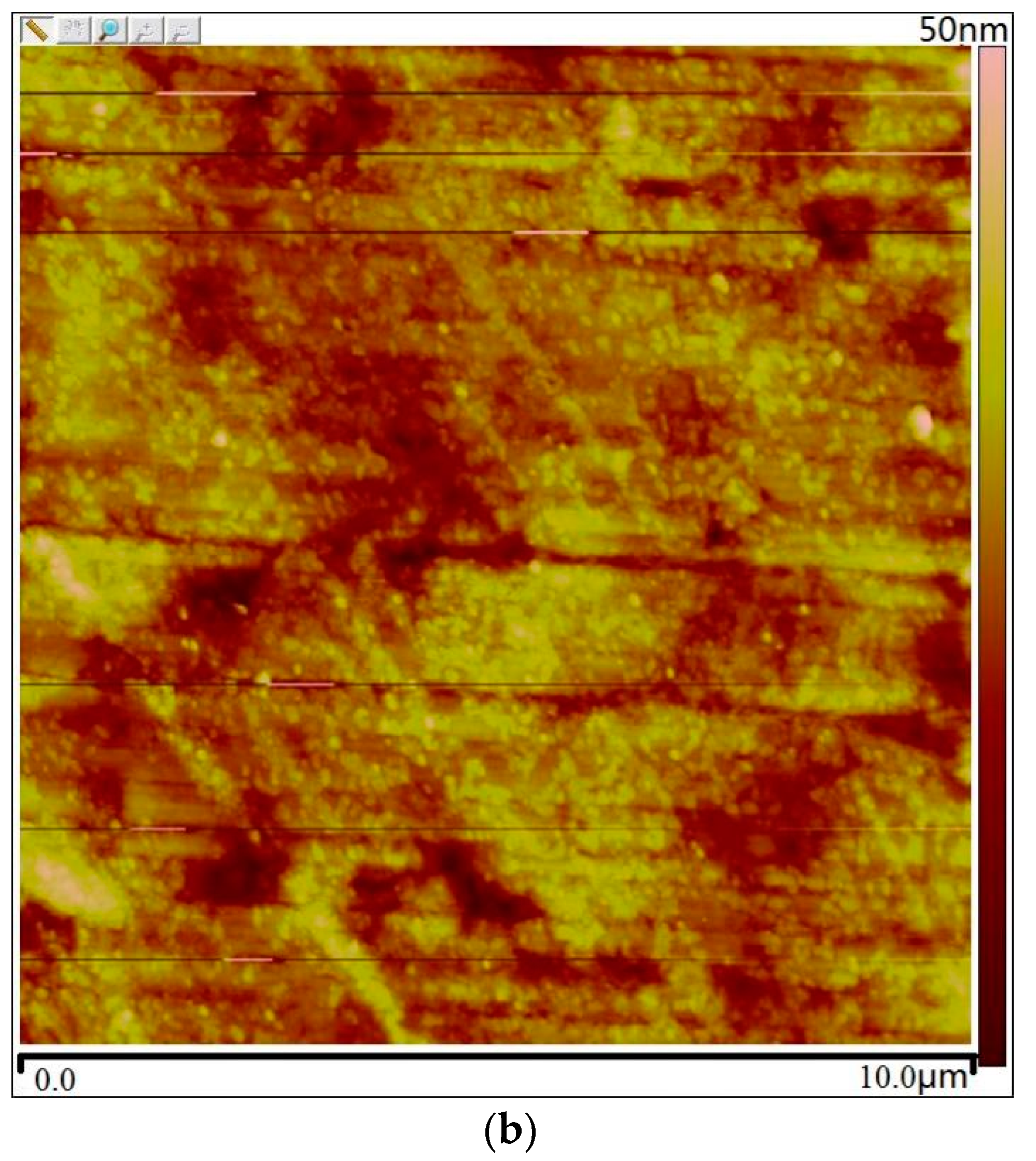
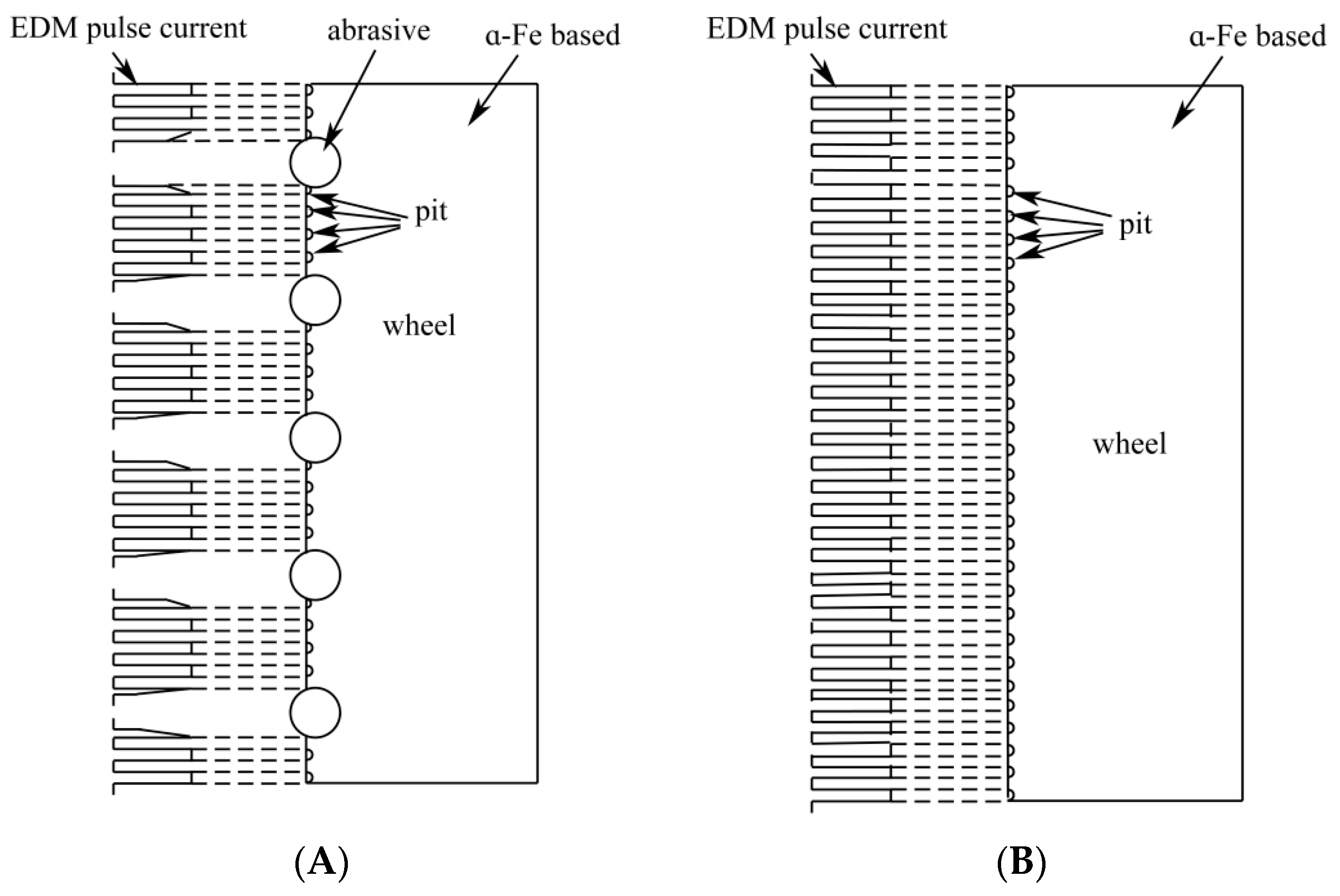
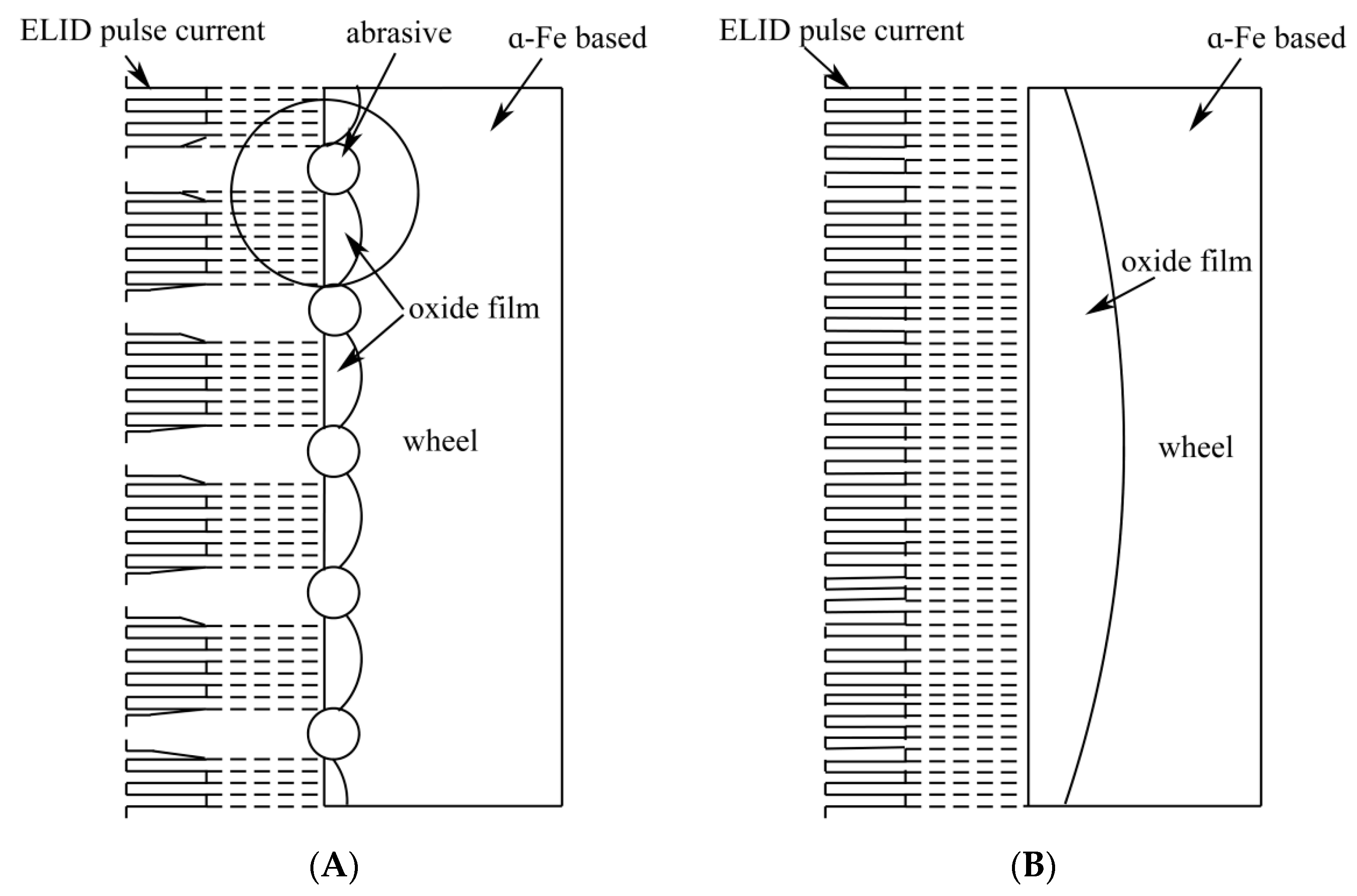
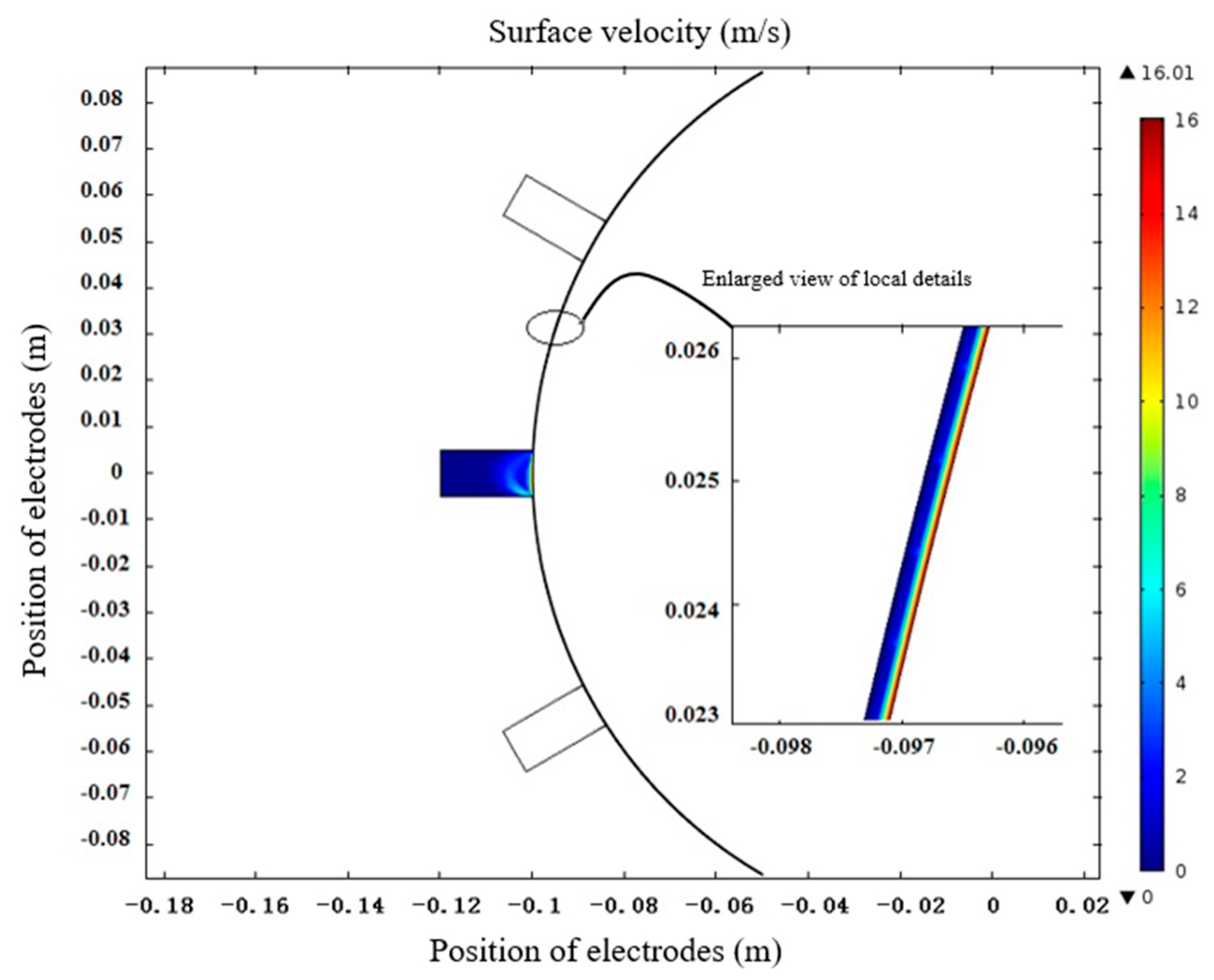
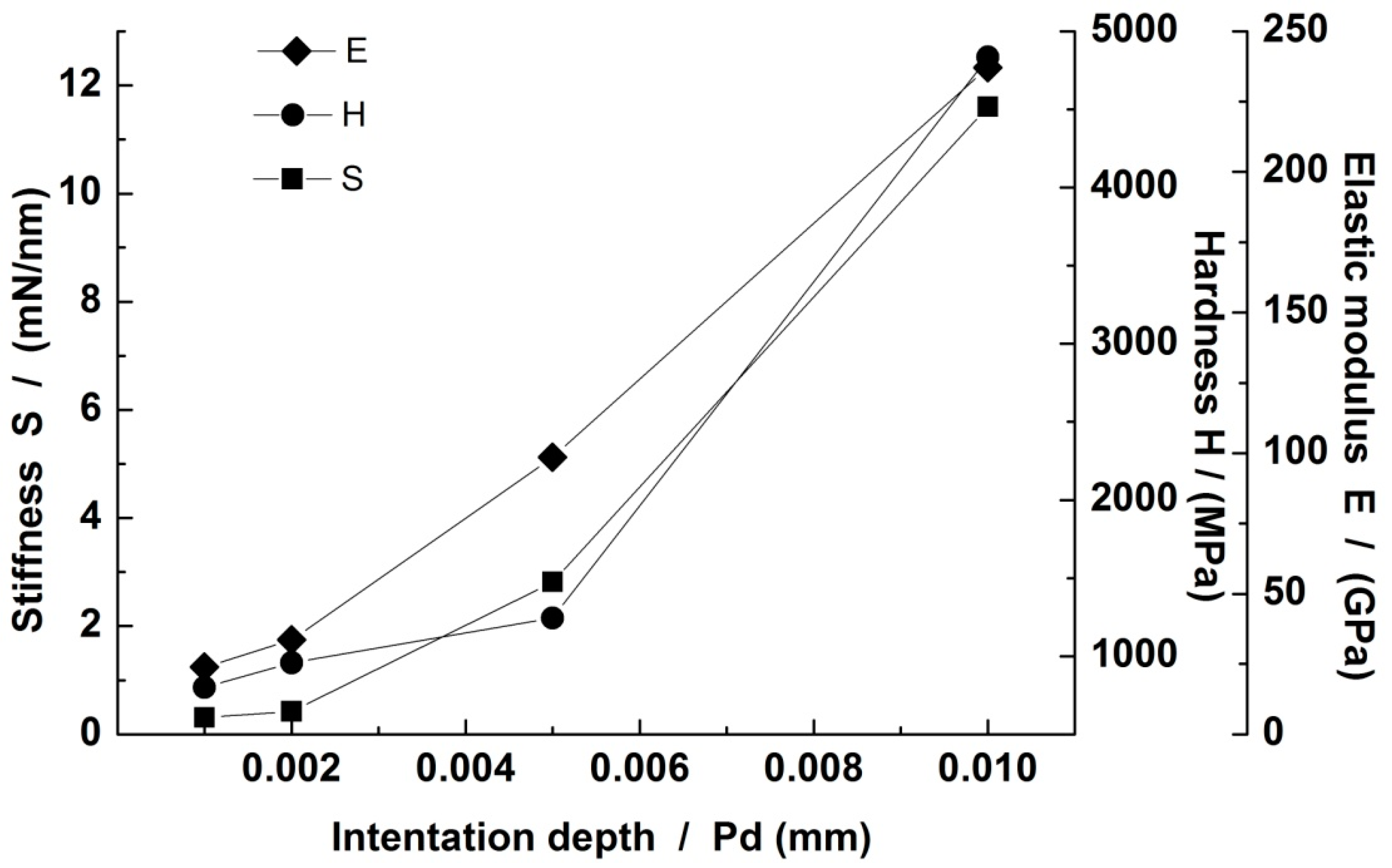
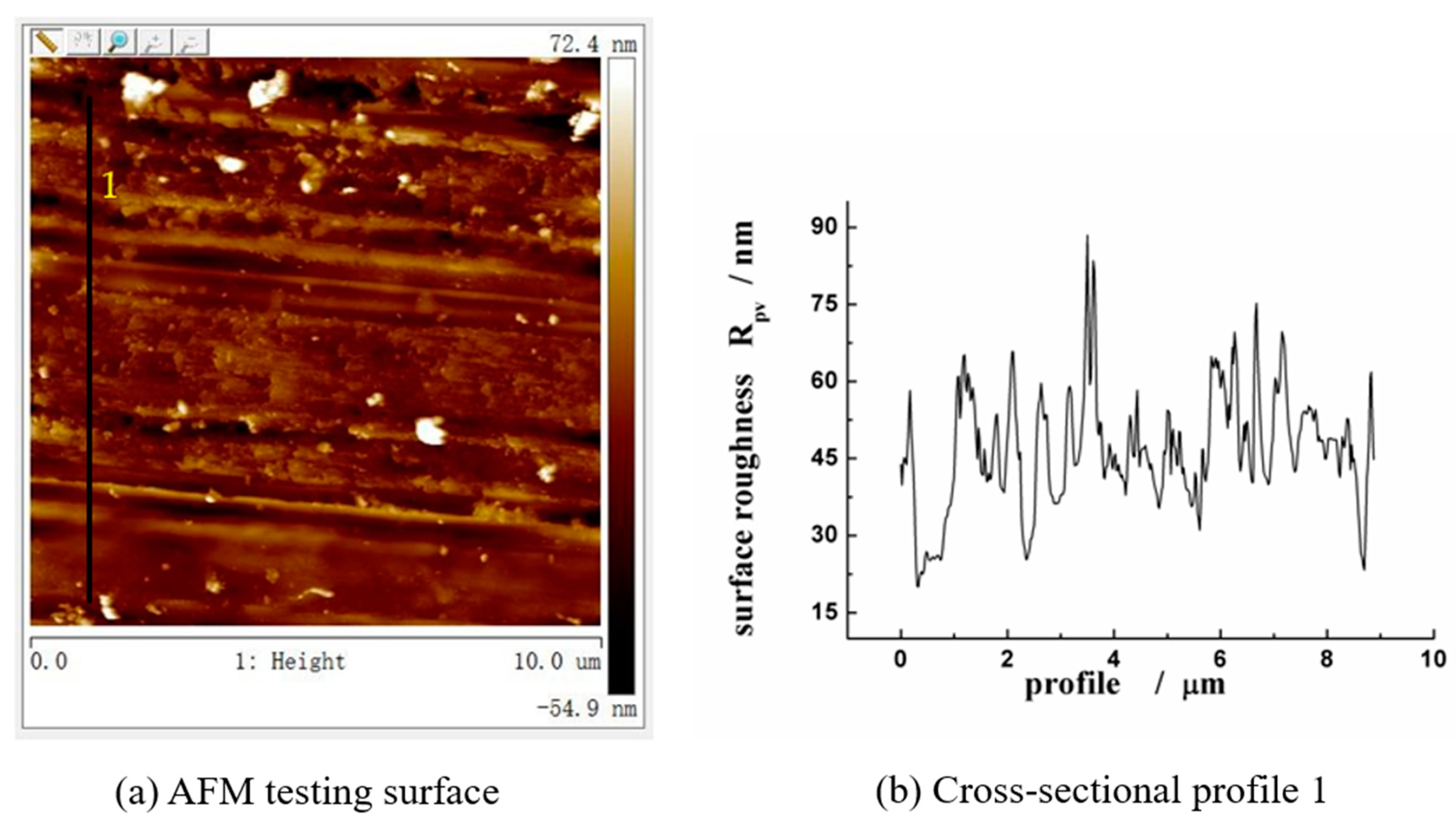

| Current | Dressing Voltage | Pulse Width (ion) | Pulse Width (ioff) | Duty Ratio | Diamond Wheel Speed | Electrode | Diamond Wheel Grain Size |
|---|---|---|---|---|---|---|---|
| 50 A | 90–120 V | 99–1 μs | 99–1 μs | 50% | 1500 RPM | Red copper | Non-abrasive, W1.5 |
Disclaimer/Publisher’s Note: The statements, opinions and data contained in all publications are solely those of the individual author(s) and contributor(s) and not of MDPI and/or the editor(s). MDPI and/or the editor(s) disclaim responsibility for any injury to people or property resulting from any ideas, methods, instructions or products referred to in the content. |
© 2023 by the authors. Licensee MDPI, Basel, Switzerland. This article is an open access article distributed under the terms and conditions of the Creative Commons Attribution (CC BY) license (https://creativecommons.org/licenses/by/4.0/).
Share and Cite
Zhang, H.; Zhang, M.; Kuai, J.; Ardashev, D.V. ELID Dressing Behaviors of Non-Abrasive Iron-Based Grinding Wheels. Appl. Sci. 2023, 13, 11047. https://doi.org/10.3390/app131911047
Zhang H, Zhang M, Kuai J, Ardashev DV. ELID Dressing Behaviors of Non-Abrasive Iron-Based Grinding Wheels. Applied Sciences. 2023; 13(19):11047. https://doi.org/10.3390/app131911047
Chicago/Turabian StyleZhang, Huali, Minghui Zhang, Jicai Kuai, and Dmitrii V. Ardashev. 2023. "ELID Dressing Behaviors of Non-Abrasive Iron-Based Grinding Wheels" Applied Sciences 13, no. 19: 11047. https://doi.org/10.3390/app131911047
APA StyleZhang, H., Zhang, M., Kuai, J., & Ardashev, D. V. (2023). ELID Dressing Behaviors of Non-Abrasive Iron-Based Grinding Wheels. Applied Sciences, 13(19), 11047. https://doi.org/10.3390/app131911047





